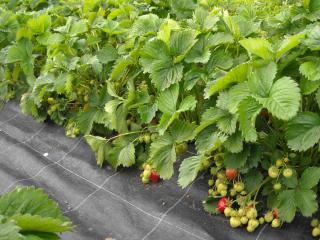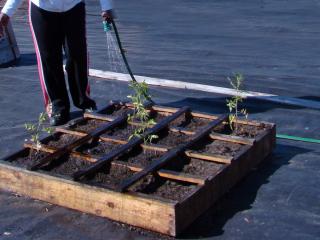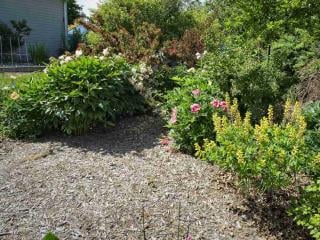

A slope in need of protection, flower beds invaded by weeds, a large plot of strawberries… It’s only normal that you’d be considering setting up synthetic mulch fabric to eliminate those long weeding chores. While benefits are clear, these mulch fabrics do have major drawbacks that you should not ignore.
Mulch fabric is a polypropylene tarp. This is a relatively durable plastic material. You can lay it on the ground of a flower bed, a border, a bank or a rockery, and even in a vegetable garden or a path.
Available in various weights and colors, these synthetic mulch fabrics or films have the unique feature of being water and air permeable, and resistant to UV rays.
Depending on the weight (from 0.5 to 2.5 oz/yd², or 20 to 130 gr/m2), they are more or less resistant to trampling.
You secure this mulch fabric to the ground with metal staples or fixing claws. Then you cut through it to plant things. However, remember it’s still plastic!
The first reason that anyone would want to install mulch fabric is the frustration with weeds, also known as adventitious plants. Indeed, whether in a flower bed or on a bank, couch grass, bindweed, dandelion and others like oxalis can quickly become invasive. To the point you might forget that these notorious weeds can still be quite useful…
Back on topic: mulch fabric will slow weed growth and, in time, suffocate them. However, this doesn’t cut it for some weeds: bindweed can still spread under a tarp!
→ To learn more: how to get rid of bindweed?

So, mulch fabric seems to be an ideal solution for people who don’t want to spend too much time in the garden or for hard-to-reach areas you only visit occasionally! On top of that, consider that it has a lifespan of up to 15 years for the thickest fabrics.
Installing a mulch fabric primarily means introducing plastic into your garden or vegetable patch. Beyond the pollution it can create, this plastic material isn’t eternal. It tears, frays, and disintegrates. And it might end up in the trash, with all challenges that its disposal presents.

But beyond these practical and aesthetic aspects, the biggest issue by far is that soil suffers from being covered by a synthetic mulch fabric. Indeed, under a fabric, soil is no longer nourished as it should be, in nature, by falling dead leaves and addition of organic material. These materials break down thanks to small fauna, bacteria, and fungi. These form humus, an essential factor for plant development.
Under a tarp, soil quickly becomes poor because it is not enriched with these nutrients. It ends up becoming infertile, causing the disappearance of all this useful microfauna. And, at the end of the chain, the perennials, shrubs and trees themselves bear the consequences: they turn deficient and more prone to diseases and parasites. As for their growth, it’s necessarily impacted.
Another drawback lies in poor water infiltration. Indeed, mulch fabrics are permeable to water and air but not enough to properly irrigate the deepest root systems. Water runs off more easily from a mulch fabric.
Finally, ground cover plants like yellow loosestrife, aubrieta, rock cress or silver basket, wall bellflower… will see their growth hindered by mulch fabric. It prevents them from spreading properly.

Other than that, mineral mulch like gravel, pebbles, or pozzolana work wonders against weed growth while adding an ornamental touch.
Lastly, plant-based or organic mulches like BRF, bark and wood chips, cocoa hulls or buckwheat husks, flax straw, miscanthus or hemp (perfect for slopes!) are the cream of the crop.
And in the vegetable garden, mulches are even more varied, celebrated and used thanks to permaculture techniques.
→ For further reading: